(Photo by Leslie Plaza Johnson/Icon Sportswire)
Colorado Rockies starting pitcher German Marquez broke out in 2018, his second full season in the majors. There was some repertoire refinement that likely contributed to his rise. He started using his slider a lot more (up 14%), which according to Pitch Info Pitch Values, got even better. His fastball usage went down 10%, perhaps due to his confidence in the slider. Again using PI pitch values, the pitch still scored in the negative but did improve. His other breaking pitch, the curve, stabilized and is gauged as an average pitch.
Getting back to the fastball, his usage in 2018 was under 50%. You might think a guy who averaged 96 MPH would want to throw it a lot more. His Bauer Unit score is a league-average 24.1 and the pitch has no serious movement when compared to league average using Pitch IQ (via Brooks Baseball).
There is a small adjustment with the potential to make a huge impact in 2019 and catapult him into elite pitcher status, allowing his fastball to become a much more potent weapon.
As mentioned, the usage is down. That’s a good thing because it means he’s trying to start mixing his pitches better and leaning in the direction of becoming more ‘liquid’ in his approach. He still has a ways to go in terms of keeping hitters off-balance. Take a look at his pitch tendency chart while acknowledging these figures certainly aren’t an anomaly in the pitching world.
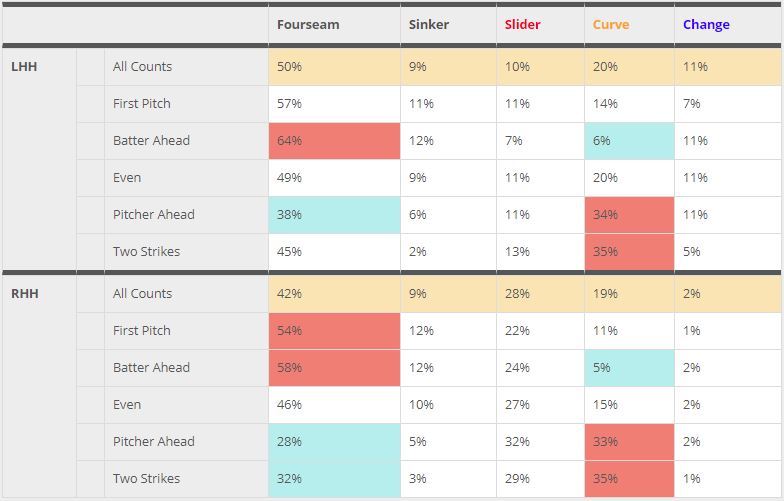
CHART 1
In Marquez’s case, you can see when the batter has an advantage; the odds (for LHH, who he faces a bit more) of getting a (4-seam/sinker) fastball are 75%. It’s slightly lower for righties but still with a level of certainty. And this proclivity isn’t unique to Marquez as I’m sure you can surmise.
When behind, righties are apt to see the fastball down and in (see Chart 2). For lefties, he throws mostly in the middle of the zone but also favors down and in along with up and away (Chart 3).
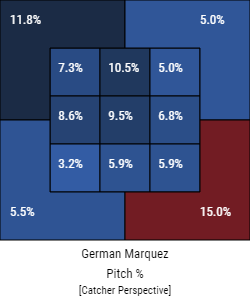
Chart 2
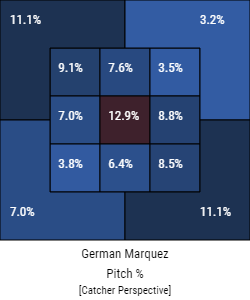
CHART 3
Those examples are more or less to piggy-back off what happens when Marquez gets behind the hitter. While he heavily favors the fastball, he understands the value of keeping his spots fairly liquid.
As mentioned, the balance of LH/RH slightly favors LHH. So, for the sake of this assessment, we’ll look at his data against LHH. Count-independent, the chart below shows Marquez’s tendencies with the fastball against lefties for his entire career.
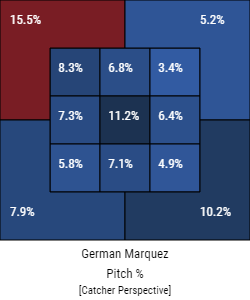
CHART 4
Chart 4 shows he lives mostly up and away (24%) and splits the middle zone along with down and in (15.1%). We can mostly ignore the middle zone because that’s the general location most pitchers go when they need a strike (behind in the count, first pitch, etc), so its a given the percentage will be higher. The majority of his fastballs to lefties, including middle up, generally go away from the hitter. I find that disconcerting because in those spots, a hitter can get his arms fully extended and the height of the pitch can help drive the ball into the outfield (or even over the fence).
How does that location work out for Marquez?
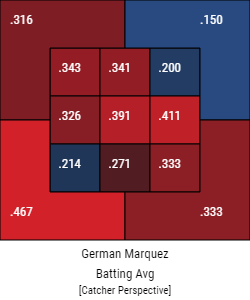
CHART 5
Observe the cart above and compare it to the location ratio in Chart 4. His batting average against is the highest in the area it’s being thrown to the most, taking area average into account and not just a single zone.
Now, what else can you glean from this chart? Well, his most effective location is up and in on lefties. It also happens to be where Marquez delivers his fastball the least. Of course, the sample size is a bit smaller and you could argue the fact that since he locates there sporadically, hitters could struggle a bit more knowing Chart 4 suggests they don’t have to pay much attention to that location.
I’m not about to suggest that Marquez live there because then he becomes predictable. What I am suggesting is he could formulate an attack plan based on the hitter’s historical weakness. To further emphasize the recommendation to move his fastball over more, know that his average exit velocity in that area is 77 MPH with an average launch angle of 36o. Chart 6 shows the expected outcome (league-wide average) under those metrics.

CHART 6
Now that I’ve established up and in fastballs to lefties are good, he can take his supplemental pitches to build tunnels off of, or to hide the fastball behind. Marquez is far better with his fastball late in the count (when ahead) than he is early- nearly .100 point decrease in batting average. Despite the fact that his batting average against still registers above league average (.286), we can work with that.
Shifting to his first supplemental pitch, the curveball, Marquez heavily favors down and in as you can see below.
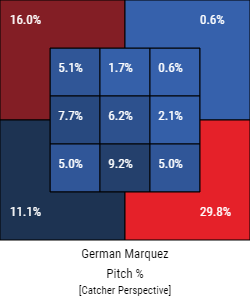
CHART 7
Its important for Marquez to keep his curve in the pressure zone or further out (in the dirt, etc). Reason being is lefties tee off on his down and in (the strike zone). It’s an almost .200 difference in batting average. Though kind of hard to see, you can make out that Marquez creates a lot of whiffs when he can properly locate his curve.

Here is a visual example of how Marquez could effectively work his curveball and fastball in tandem.

Notice when the fastball came, Marwin Gonzalez was still timed to the curveball that he almost put in play. Marquez created a great tunnel that stayed together past the commit point and broke apart when it was too late for the hitter. Gonzalez was late on the fastball despite making a good swing angle adjustment; nevermind the fact that Marquez’s Effective Velocity spread was a terrific +10EvMPH.
Despite all of that, a word of caution. Through the effective velocity lense, it was more about Gonzalez’s mistakes. The location of both of those pitches is dangerous- the curveball landed in one of the worst spots in terms of batting average against and could have been crushed if Gonzalez was a few milliseconds quicker. What’s more is the fastball located more middle up than middle in; another bad location for Marquez. But, Marquez was able to be a bit liquid with his pitch selection during this entire plate appearance (SL>FB>SL>CB>CB>FB) and did a decent job keeping Gonzalez off-balance.
So what about that slider? How can he make that work with the fastball? What about in conjunction with the curve? We are going to look at this from an Effective Velocity ecosystem standpoint.
Tunneled sliders and fastballs can work well so long as the fastball stays up and compliments the breaking pitch. The average velocity between the two pitches is about 10 MPH for Marquez and if you’re familiar with the Perry Husband-established Ev rules, it breaks the 6EvMPH threshold which lowers the threat of hard contact and assists in timing disruption. This is important because you want to avoid putting the fastball in the minus zone (away) while putting the slider in the plus zone (see image below).
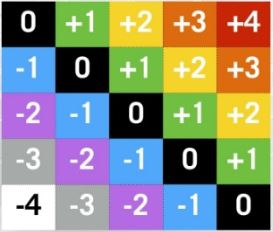
From the catcher’s point of view, you see (in terms of time units) that pitches up and/or into a LHH gain velocity whiles pitches down and/or away lose velocity. This makes his location of those pitches, when tunneled, important because if the fastball (95 MPH) is down, it will lose velocity while the slider will gain velocity thereby bringing the pitch speed closer together. For example, a 95 MPH fastball that loses 4 EvMPH and a slider that gains 4 EvMPH will effectively create a spread of roughly 3-4 EvMPH. As mentioned before, that spread increases the possibility of hard hit (or damaging) contact. To put that in further context, see my article here for an explanation of how the hitter’s attention zone could take advantage of this Ev mistake.
If you don’t buy into Ev concepts and you’re going to point to the relevance of spin (axis) and movement, you’re not wrong. These concepts are part of Effective Velocity as well. Take a look at the chart below to reference movement of his three main pitches.
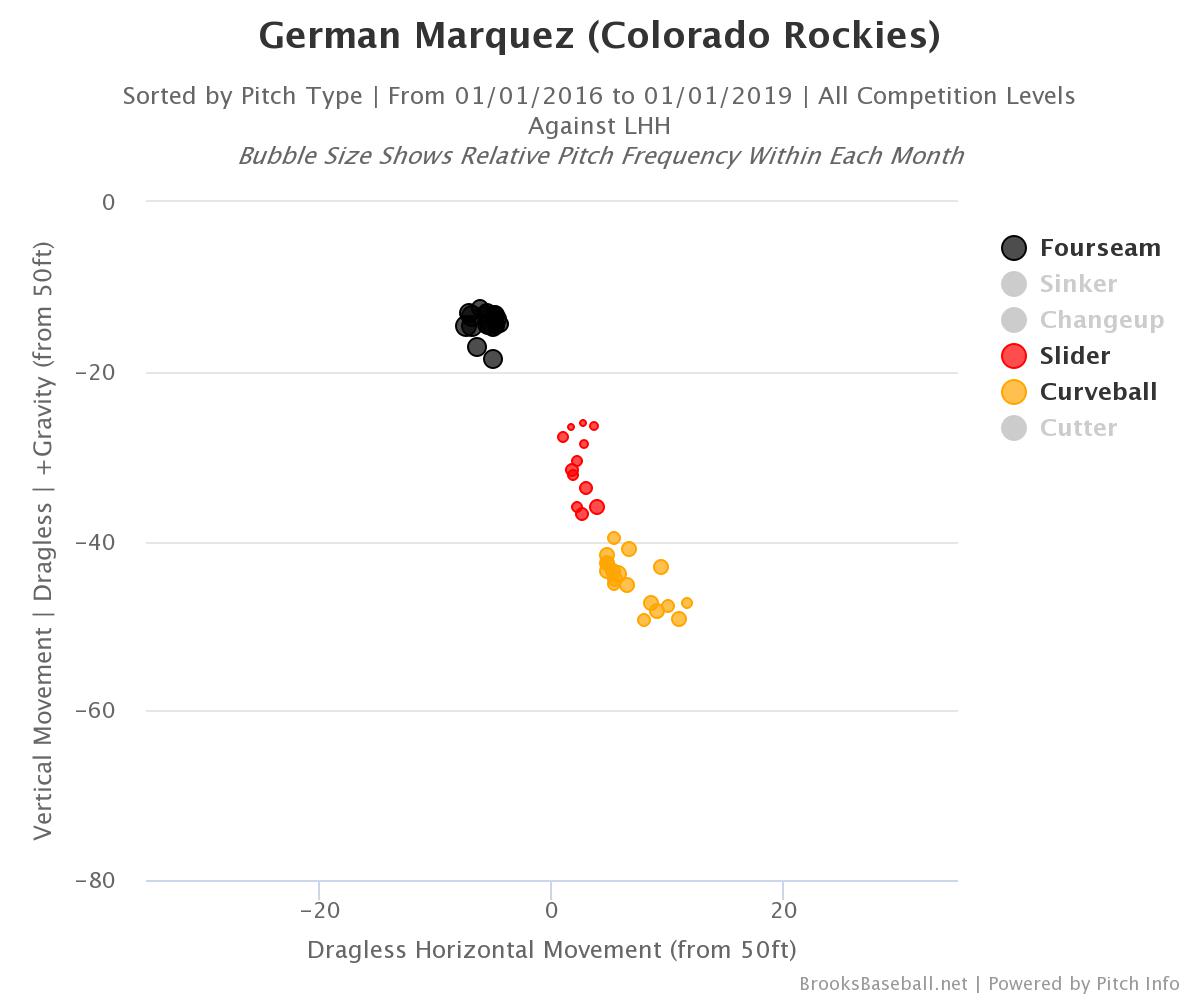
You see his slider movement parallels his curveball, albeit, with less break. With the curve and slider so close in velocity, they are going to have to be placed strategically. Either using the fastball before or after one of the other pitches (eg- SL>FB>CB or CB>FB>SL) This spreads velocity enough to disrupt the hitter’s timing, which is essential to Effective Velocity.
The gif below represents the best Ev ecosystem I could find for Marquez. This closely represents how he wants those three pitches to work together, but its still not ideal.

The slider (middle location) sets the trajectory for the tunnel and can yield either a ball or strike. It doesn’t necessarily matter because, again, we are focused on timing (whiffs are icing on the cake). Marquez can then use the fastball up and in riding the tunnel set up by the slider as for as long and as close as possible. Then, Marquez can add the curveball to the tunnel that was just created, keeping in mind location to enable the velocity spread to continue. This is especially beneficial for Marquez because his slider and curve are close in velocity and move similarly; the slider with much less break and slightly more horizontal movement. Best case scenario for the hitter, after seeing the slider and the fastball, could notice the movement on the pitch and would have to guess either slider or curve. He guesses wrong either way and it’s an embarrassing whiff.
The most important thing working in Marquez’s favor using this approach is his amazingly close average release point for each pitch. I liken it to a golfer who can drive the ball 400 yards with the only remaining factor being his short game. Marquez would benefit greatly from some work on creating tunnels.
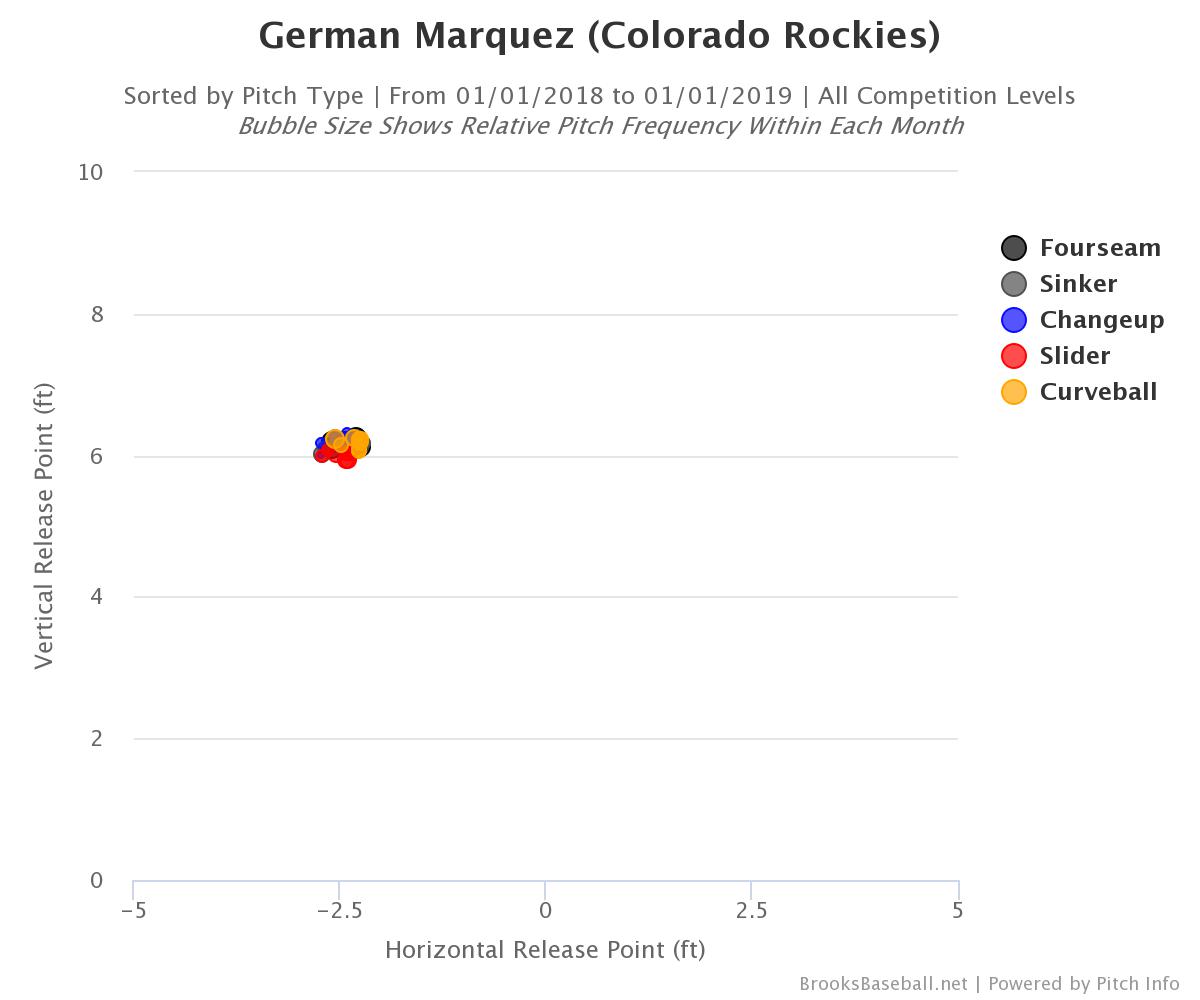
I don’t want you to think I expect Marquez to do exactly this each time he faces a new hitter. This is a valuable tool that can be used depending on what the hitter’s expected game plan is. This is how liquidity when pitching is valuable because you don’t want to give them an advantage based on repeated tendencies. Look to how Johan Santana handled hitters with two strikes during his peak. His approach was very liquid while most pitchers have a go-to strikeout pitch; some of which are so nasty (see: Mariano Rivera) that it doesn’t matter if the hitter knows what’s coming.
The reason I didn’t key in on RHH is that Marquez simply needs to become more accurate in that location (see below). There have been 19 batted ball events in that location since 2017 resulting in a .316 batting average against. Once the accuracy tightens up, hitters can take the pitch (location) more seriously which then allows him to work an Ev ecosystem around that location.

What I’m suggesting for Marquez is to use the fastball up and in more (to either RH or LH hitters) and build a plan around using the pitch in that manner. You can add velocity in that spot by forcing a hitter to react quicker than he is ready to and subsequently giving him much more to think about. When you have a blink of an eye to make a decision, hitting is all about timing. The Marquez example is how pitchers could make themselves better.

Thanks for all the work on this!
Did you uncover tweaks Marquez made last year that could explain some of the reason he put up a 2.25 era / 2.23 fip / 2.25 xfip and 12k/9 over his last 13 starts last year? You could argue he’s already in elite pitcher status if he keeps that up.